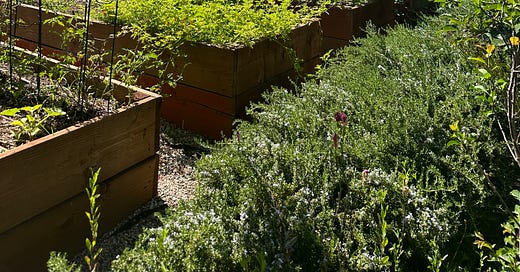Happy Friday! Welcome to the first installment of Garden Essentials, a new weekly series where we’ll dive into the core elements of gardening. Think of this as your foundation—over the coming weeks, we’ll explore things like sun, compost, water, soil, mulch, companion planting, temperature, seeds, and pests. No matter where you live, these are the essentials you need to know before you get started gardening.
These lessons didn’t come easy. I’ve spent the last decade learning through trial and error, without any formal training. My goal with this Substack, and with Carmen in the Garden in general, is to share what I’ve learned, so you can grow your own garden with confidence—and create your own sanctuary filled with joy and abundance.
Today, we’re starting with the most fundamental element of gardening: the sun. Whenever someone comes to me with garden troubles, my first question is always about sunlight. Where are you trying to grow, and what is the light like? In today’s post, we’ll cover:
Why sunlight is essential for plants, with personal anecdotes from my own gardening experience, including how sunlight impacts plant health and productivity—from root development to flowering and fruiting.
How to figure out how much sunlight your garden gets, covering sun direction, tracking sunlight throughout the day, building shade, and creating microclimates in your garden.
The role of sunlight in determining “seasons” and how seasonal sunlight shifts, beyond just temperature changes, affect your garden.
Common sunlight issues I often see, such as too much or too little sunlight, and how to troubleshoot them.
A list of plants you can grow in each sunlight category.
Today’s post is for paid subscribers, who will get full access to my archive, weekly in-depth newsletters like this one, and exclusive perks, including early access to upcoming launches.
Why Sunlight is Essential for Plants
Photosynthesis: The Powerhouse Process
At its core, sunlight is the energy source that fuels plants' ability to create food. Through a process called photosynthesis (which we’ve all heard of), plants use sunlight to convert carbon dioxide (from the air) and water (from the soil) into glucose (a type of sugar). This glucose is their primary energy source, allowing them to grow, flower, and produce fruit.
Think of sunlight as the plant’s daily meal. Without enough sunlight, they can’t “eat,” and their growth suffers. Too much sunlight, however, can be like a sunburn, causing stress or even damage.
In my early gardening days, I had a shady corner where I stubbornly tried growing tomatoes. No matter how much I watered them or enriched the soil, they remained spindly and never produced much fruit. It took a few seasons (and a lot of frustration) to learn that tomatoes need at least 6 hours of direct sunlight a day to thrive.
Sunlight’s Role in Plant Health
Adequate sunlight encourages deep and healthy root growth. Roots act as the plant’s anchor, absorbing nutrients and water from the soil. Without enough sunlight, plants can grow “leggy”—where they stretch tall with weak stems and shallow roots as they try to reach more light. Legginess can be one of the first signs that your garden spot doesn’t have enough sun. More on that later…
Many plants rely on long periods of sunlight (known as “long-day plants”) to produce flowers and fruits. Flowers, in turn, are crucial for reproduction - the flowers on most of your plants become the thing you end up harvesting. So, if your plant isn’t flowering, one of the first things to check is whether it’s getting enough sun.
Sunlight and Plant Productivity
Plants use glucose (from photosynthesis) as their “fuel.” The more sunlight they receive, the more glucose they can produce, which directly translates to faster growth and higher productivity. For example, Leafy greens, like lettuce or spinach, will grow faster in adequate sunlight and produce larger, healthier leaves. However, too much direct sun can cause these plants to “bolt” (flower too early), leading to bitter-tasting greens.
For fruiting plants, like tomatoes, peppers, and squash, sunlight is essential for both the number of fruits produced and their quality. Without enough sunlight, fruits may be smaller or fewer in number. If you’re aiming for high yields in fruiting plants, prioritize areas with full sun—at least 6-8 hours of direct sunlight.
How to Figure Out How Much Sunlight Your Garden Gets
Understanding Categories of Sunlight
To plan your garden effectively, it’s essential to understand the categories of sunlight, defined by the number of hours of direct exposure:





